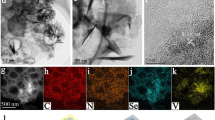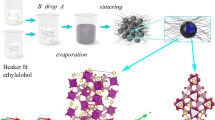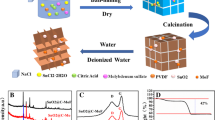Abstract
With the shortage of lithium resources caused by the development of lithium-ion batteries, sodium-ion batteries have attracted research interest. Vanadium diselenide (VSe2), a transition metal disulfide compound with large layer spacing, is very promising to be utilized in sodium-ion batteries. However, the material suffers from great volume changes and disordered stacking agglomeration during battery charging and discharging, which brings bad effects on its electrochemical performance. For this reason, the nitrogen-fluorine co-doped three-dimensional carbon framework embedded VSe2 nanosheet (VSe2@3D-CNF) material was prepared by high-energy ball milling method. The three-dimensional carbon framework structure can well alleviate the volume expansion caused by charging and discharging, while avoiding the problem of no stacking of VSe2 during charging and discharging, which is beneficial to improve the stability of the electrode material, and the N and F double doping can increase the active sites and improve the electron transfer rate. The results show that the reversible capacity of VSe2@3D-CNF composite after 200 cycles at a current density of 200 mA g−1 is 447.3 mAh g−1, and the Coulomb efficiency is 99.32%. The rate capacities are 522.4, 465, 433.9, 403.4, 367.7, and 283.6 mAh g−1 at current densities of 0.1, 0.2, 0.3, 0.5, 1, and 2 A g−1, and the long cycle performance was 335.5 mAh g−1 after 500 cycles at a high current density of 1 A g−1. The above results indicate that VSe2@3D-CNF composites are very promising for application in anode materials for SIBs.






Similar content being viewed by others
Data availability
The data that support the findings of this study are available on request from the corresponding author upon reasonable request.
References
Omer AM (2008) Energy, environment and sustainable development. Renew Sustain Energy Rev 12:2265–2300. https://doi.org/10.1016/j.rser.2007.05.001
Wang Q, Ping P, Zhao X, Chu G, Sun J, Chen C (2012) Thermal runaway caused fire and explosion of lithium ion battery. J Power Sources 208:210–224. https://doi.org/10.1016/j.jpowsour.2012.02.038
Gratzel M (2001) Photoelectrochemical cells. Nature 414:338–344. https://doi.org/10.1038/35104607
Demirbas A (2005) Potential applications of renewable energy sources, biomass combustion problems in boiler power systems and combustion related environmental issues. Prog Energy Combust Sci 31:171–192. https://doi.org/10.1016/j.pecs.2005.02.002
Jacobson MZ (2009) Review of solutions to global warming, air pollution, and energy security. Energy Environ Sci 2:148–173. https://doi.org/10.1039/b809990c
Kundu D, Talaie E, Duffort V, Nazar LF (2015) The Emerging chemistry of sodium ion batteries for electrochemical energy storage. Angew Chemie-Int Ed 54:3431–3448. https://doi.org/10.1002/anie.201410376
Goodenough JB, Kim Y (2010) Challenges for rechargeable Li batteries. Chem Mater 22:587–603. https://doi.org/10.1021/cm901452z
Tarascon JM, Armand M (2001) Issues and challenges facing rechargeable lithium batteries. Nature 414:359–367. https://doi.org/10.1038/35104644
Hwang J-Y, Myung S-T, Sun Y-K (2017) Sodium-ion batteries: present and future. Chem Soc Rev 46:3529–3614. https://doi.org/10.1039/c6cs00776g
Kim S-W, Seo D-H, Ma X, Ceder G, Kang K (2012) Electrode materials for rechargeable sodium-ion batteries: potential alternatives to current lithium-ion batteries. Adv Energy Mater 2:710–721. https://doi.org/10.1002/aenm.201200026
Yabuuchi N, Kubota K, Dahbi M, Komaba S (2014) Research development on sodium-ion batteries. Chem Rev 114:11636–11682. https://doi.org/10.1021/cr500192f
Luo W, Shen F, Bommier C, Zhu H, Ji X, Hu L (2016) Na-ion battery anodes: materials and electrochemistry. Acc Chem Res 49:231–240. https://doi.org/10.1021/acs.accounts.5b00482
Yang X, Zhang R-Y, Zhao J, Wei Z-X, Wang D-X, Bie X-F, Gao Y, Wang J, Du F, Chen G (2018) Amorphous tin-based composite oxide: a high-rate and ultralong-life sodium-ion-storage material. Adv Energy Mater 8:1701827. https://doi.org/10.1002/aenm.201701827
Alcantara R, Jaraba M, Lavela P, Tirado JL (2002) NiCo2O4 spinel: First report on a transition metal oxide for the negative electrode of sodium-ion batteries. Chem Mater 14:2847. https://doi.org/10.1021/cm025556v
Yun Q, Li L, Hu Z, Lu Q, Chen B, Zhang H (2020) Layered transition metal dichalcogenide-based nanomaterials for electrochemical energy storage. Adv Mater 32:1903826. https://doi.org/10.1002/adma.201903826
Ming F, Liang H, Lei Y, Zhang W, Alshareef HN (2018) Solution synthesis of VSe2 nanosheets and their alkali metal ion storage performance. Nano Energy 53:11–16. https://doi.org/10.1016/j.nanoen.2018.08.035
Xue Z, Feng Y, Lei J, Wu S, Xiong D, Chen L, Feng Z, Wen K, Li Z, He M (2023) VSe2 ultrathin nanosheets embedded in a three-dimensional N-doped carbon framework with enhanced cycling performance for sodium-ion battery. Ionics 29:1127–1138. https://doi.org/10.1007/s11581-022-04868-x
Yi Y, Du X, Zhao Z, Liu Y, Guan H, Liu X, Pei X, Zhang S, Li D (2022) Coupling of metallic vse2 and conductive polypyrrole for boosted sodium-ion storage by reinforced conductivity within and outside. ACS Nano 16:7772–7782. https://doi.org/10.1021/acsnano.2c00169
Zhang H, Xiong D, Xie Y, Zhang H, Feng Z, Wen K, Li Z, He M (2023) A simple synthesis of VSe2/B4C@HCG composite as high-performance anodes for sodium-ion batteries. J Alloys Compd 935:168111. https://doi.org/10.1016/j.jallcom.2022.168111
Pang J, Mendes RG, Bachmatiuk A, Zhao L, Ta HQ, Gemming T, Liu H, Liu Z, Rummeli MH (2019) Applications of 2D MXenes in energy conversion and storage systems. Chem Soc Rev 48:72–133. https://doi.org/10.1039/c8cs00324f
Hu Z, Liu Q, Chou S-L, Dou S-X (2017) Advances and challenges in metal sulfides/selenides for next-generation rechargeable sodium-ion batteries. Adv Mater 29. https://doi.org/10.1002/adma.201700606
Wang W, Wang X, Chen L, Lu D, Zhou W, Li Y (2023) Conductive metal-metal phase and built-in electric field of 1T-VSe2-MXene hetero-structure to accelerate dual-directional sulfur conversion for high-performance Li-S batteries. Chem Eng J 461:142100. https://doi.org/10.1016/j.cej.2023.142100
Lu P, Sun Y, Xiang H, Liang X, Yu Y (2018) 3D Amorphous carbon with controlled porous and disordered structures as a high-rate anode material for sodium-ion batteries. Adv Energy Mater 8:1702434. https://doi.org/10.1002/aenm.201702434
Zhang N, Han X, Liu Y, Hu X, Zhao Q, Chen J (2015) 3D Porous gamma-Fe2O3@C nanocomposite as high-performance anode material of na-ion batteries. Adv Energy Mater 5:1401123. https://doi.org/10.1002/aenm.201401123
Li Y, Chen M, Liu B, Zhang Y, Liang X, Xia X (2020) Heteroatom doping: an effective way to boost sodium ion storage. Adv Energy Mater 10:2000927. https://doi.org/10.1002/aenm.202000927
Lv D, Wang D, Wang N, Liu H, Zhang S, Zhu Y, Song K, Yang J, Qian Y (2022) Nitrogen and fluorine co-doped TiO2/carbon microspheres for advanced anodes in sodium-ion batteries: high volumetric capacity, superior power density and large areal capacity. J Energy Chem 68:104–112. https://doi.org/10.1016/j.jechem.2021.11.040
Huang S, Li Y, Feng Y, An H, Long P, Qin C, Feng W (2015) Nitrogen and fluorine co-doped graphene as a high-performance anode material for lithium-ion batteries. J Mater Chem A 3:23095–23105. https://doi.org/10.1039/c5ta06012e
Lu Y, Zhou YP, Yan QY, Fong E (2016) Bio-inspired synthesis of N, F co-doped 3D graphitized carbon foams containing manganese fluoride nanocrystals for lithium ion batteries. J Mater Chem A 4:2691–2698. https://doi.org/10.1039/c5ta09185c
Wu Z, Lu C, Wang Y, Zhang L, Jiang L, Tian W, Cai C, Gu Q, Sun Z, Hu L (2020) Ultrathin VSe2 nanosheets with fast ion diffusion and robust structural stability for rechargeable zinc-ion battery cathode. Small 16:2000698. https://doi.org/10.1002/smll.202000698
Yang C, Feng J, Lv F, Zhou J, Lin C, Wang K, Zhang Y, Yang Y, Wang W, Li J, Guo S (2018) Metallic graphene-like VSe2 ultrathin nanosheets: superior potassium-ion storage and their working mechanism. Adv Mater 30:1800036. https://doi.org/10.1002/adma.201800036
Wang Y, Li J, Li X, Jin H, Ali W, Song Z, Ding S (2022) Metal-organic-framework derived Co@CN modified horizontally aligned graphene oxide array as free-standing anode for lithium-ion batteries. J Mater Chem A 10:699–706. https://doi.org/10.1039/d1ta07638h
Wang B, Al Abdulla W, Wang D, Zhao XS (2015) A three-dimensional porous LiFePO4 cathode material modified with a nitrogen-doped graphene aerogel for high-power lithium ion batteries. Energy Environ Sci 8:869–875. https://doi.org/10.1039/c4ee03825h
Qi J, Wu T, Xu M, Xiao Z (2021) Hierarchical assembly of CNTs-VSe2-VOx/S for flexible lithium-sulfur batteries. ACS Appl Mater Interfaces 13:39186–39194. https://doi.org/10.1021/acsami.1c07204
Sha D, Lu C, He W, Ding J, Zhang H, Bao Z, Cao X, Fan J, Dou Y, Pan L, Sun Z (2022) Surface selenization strategy for V2CTx MXene toward superior Zn-ion storage. ACS Nano 16:2711–2720. https://doi.org/10.1021/acsnano.1c09639
Yang J, Luo J, Kuang Y, He Y, Wen P, Xiong L, Wang X, Yang Z (2021) Exploring the efficient Na/K storage mechanism and vacancy defect-boosted Li+ diffusion based on VSe2/MoSe2 heterostructure engineering. ACS Appl Mater Interfaces 13:2072–2080. https://doi.org/10.1021/acsami.0c19934
Li B, Dai F, Xiao Q, Yang L, Shen J, Zhang C, Cai M (2016) Nitrogen-doped activated carbon for a high energy hybrid supercapacitor. Energy Environ Sci 9:102–106. https://doi.org/10.1039/c5ee03149d
Qie L, Chen W-M, Wang Z-H, Shao Q-G, Li X, Yuan L-X, Hu X-L, Zhang W-X, Huang Y-H (2012) Nitrogen-doped porous carbon nanofiber webs as anodes for lithium ion batteries with a superhigh capacity and rate capability. Adv Mater 24:2047–2050. https://doi.org/10.1002/adma.201104634
Zhou G, Paek E, Hwang GS, Manthiram A (2015) Long-life Li/polysulphide batteries with high sulphur loading enabled by lightweight three-dimensional nitrogen/sulphur-codoped graphene sponge. Nat Commun 6:7760. https://doi.org/10.1038/ncomms8760
Li Z, Li X, Zhou L, Xiao Z, Zhou S, Zhang X, Li L, Zhi L (2018) A synergistic strategy for stable lithium metal anodes using 3D fluorine-doped graphene shuttle-implanted porous carbon networks. Nano Energy 49:179–185. https://doi.org/10.1016/j.nanoen.2018.04.040
Liu K, Zhang Q, Dai S, Li W, Liu X, Ding F, Zhang J (2018) Synergistic effect of F- doping and LiF coating on improving the high-voltage cycling stability and rate capacity of LiNi0.5Co0.2Mn0.3O2 cathode materials for lithium-ion batteries. Acs Appl Mater Interfaces 10:34153–34162. https://doi.org/10.1021/acsami.8b10016
Wang X, Feng Z, Hou X, Liu L, He M, He X, Huang J, Wen Z (2020) Fluorine doped carbon coating of LiFePO4 as a cathode material for lithium-ion batteries. Chem Eng J 379:122371. https://doi.org/10.1016/j.cej.2019.122371
Wu R, Qian X, Yu F, Liu H, Zhou K, Wei J, Huang Y (2013) MOF-templated formation of porous CuO hollow octahedra for lithium-ion battery anode materials. J Mater Chem A 1:11126–11129. https://doi.org/10.1039/c3ta12621h
Zhao Y, Li X, Yan B, Xiong D, Li D, Lawes S, Sun X (2016) Recent developments and understanding of novel mixed transition-metal oxides as anodes in lithium ion batteries. Adv Energy Mater 6:1502175. https://doi.org/10.1002/aenm.201502175
Wu Y, Chen H, Zhang L, Li Q, Xu M, Bao S-J (2019) A rough endoplasmic reticulum-like VSe2/rGO anode for superior sodium-ion capacitors, Inorganic Chemistry. Frontiers 6:2935–2943. https://doi.org/10.1039/c9qi00809h
Song J, Yu Z, Gordin ML, Hu S, Yi R, Tang D, Walter T, Regula M, Choi D, Li X, Maniyannan A, Wang D (2014) Chemically bonded phosphorus/graphene hybrid as a high performance anode for sodium-ion batteries. Nano Lett 14:6329–6335. https://doi.org/10.1021/nl502759z
Song K, Liu C, Mi L, Chou S, Chen W, Shen C (2021) Recent progress on the alloy-based anode for sodium-ion batteries and potassium-ion batteries. Small 17:1903194. https://doi.org/10.1002/smll.201903194
Su D, Dou S, Wang G (2015) Ultrathin MoS2 nanosheets as anode materials for sodium-ion batteries with superior performance. Adv Energy Mater 5:1401205. https://doi.org/10.1002/aenm.201401205
Wang T, Su D, Shanmukaraj D, Rojo T, Armand M, Wang G (2018) Electrode materials for sodium-ion batteries: considerations on crystal structures and sodium storage mechanisms. Electrochem Energy Rev 1:200–237. https://doi.org/10.1007/s41918-018-0009-9
Hu X, Sun X, Yoo SJ, Evanko B, Fan F, Cai S, Zheng C, Hu W, Stucky GD (2019) Nitrogen-rich hierarchically porous carbon as a high-rate anode material with ultra-stable cyclability and high capacity for capacitive sodium-ion batteries. Nano Energy 56:828–839. https://doi.org/10.1016/j.nanoen.2018.11.081
Ni D, Sun W, Wang Z, Bai Y, Lei H, Lai X, Sun K (2019) Heteroatom-doped mesoporous hollow carbon spheres for fast sodium storage with an ultralong cycle life. Adv Energy Mater 9:1900036. https://doi.org/10.1002/aenm.201900036
Zhao X, Gong F, Zhao Y, Huang B, Qian D, Wang H-E, Zhang W, Yang Z (2020) Encapsulating NiS nanocrystal into nitrogen-doped carbon framework for high performance sodium/potassium-ion storage. Chem Eng J 392:123675. https://doi.org/10.1016/j.cej.2019.123675
Shao H, Lin Z, Xu K, Taberna P-L, Simon P (2019) Electrochemical study of pseudocapacitive behavior of Ti3C2Tx MXene material in aqueous electrolytes. Energy Storage Mater 18:456–461. https://doi.org/10.1016/j.ensm.2018.12.017
Ding C, Huang T, Tao Y, Tan D, Zhang Y, Wang F, Yu F, Xie Q (2018) Identifying the origin and contribution of pseudocapacitive sodium ion storage in tungsten disulphide nanosheets for application in sodium-ion capacitors. J Mater Chem A 6:21010–21017. https://doi.org/10.1039/c8ta07677d
Funding
This work was generously supported by the State Key Laboratory of Precision Electronic Manufacturing Technology and Equipment, Guangdong University of Technology, China.
Author information
Authors and Affiliations
Contributions
Jinxuan Lei: conceptualization, validation, investigation, and writing—original draft. Chenhao Xu: formal analysis, methodology, and investigation. Zhifeng Xue: formal analysis, methodology, and investigation. Wenbin Ye: formal analysis. Zuyong Feng: formal analysis. Miao He: supervision, project administration, and funding acquisition. Kunhua Wen: formal analysis. Li Chen: formal analysis. Deping Xiong: formal analysis. All authors reviewed the manuscript.
Corresponding author
Ethics declarations
Ethics approval
Not applicable.
Competing interests
The authors declare no competing interests.
Additional information
Publisher's Note
Springer Nature remains neutral with regard to jurisdictional claims in published maps and institutional affiliations.
Supplementary Information
Below is the link to the electronic supplementary material.
Rights and permissions
Springer Nature or its licensor (e.g. a society or other partner) holds exclusive rights to this article under a publishing agreement with the author(s) or other rightsholder(s); author self-archiving of the accepted manuscript version of this article is solely governed by the terms of such publishing agreement and applicable law.
About this article
Cite this article
Lei, J., Xu, C., Xue, Z. et al. Nitrogen and fluorine co-doped 3D carbon framework embedded VSe2 nanosheets as high-performance sodium-ion battery anode materials. Ionics 30, 2127–2137 (2024). https://doi.org/10.1007/s11581-024-05437-0
Received:
Revised:
Accepted:
Published:
Issue Date:
DOI: https://doi.org/10.1007/s11581-024-05437-0




